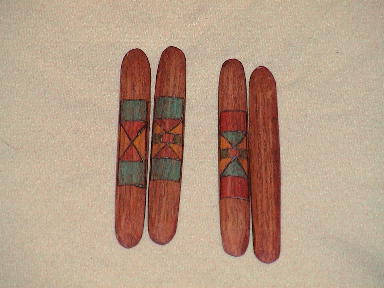| A very traditional Nimíipuu game, shared throughout the Plateau region is called Céexstem, a form of dice game. Formally played by women, today both men and women of all ages enjoy the excitement of Céexstem. The goal of the game is to see who can reach the agreed upon point total first. Any number of individuals can play at one time. The game is a wonderful way to learn the number system of the Nimíipuu, counting from náaqc (one) to le 'dptit (twenty), and have a lot of fun doing so!
|
|
Kevin Peters and Josiah Pinkham explain the point possibilities in the game of Céexstem (Interviewed by Rodney Frey, March 2002).
|
To play the game, you need two sets of game sticks, each set colored a different color, e.g., blue and red, and each set marked indicating a áayet (male) and hamma (female), a "couple." The male stick is often marked with an extra perpendicular line across it. The reverse side of a stick is called, caya, "nothing." Before starting the players agree upon the number of points to win, the higher the number, the more challenging and the more fun. Typically, 5, 7 or 11 point totals are selected. Usually starting with the youngest player and proceeding to that person's right, each person throws the four game sticks onto the rug before them. Depending on how the sticks land, the following points are possible.
- one "couple," a áayet and a hamma of the same color = one point
- two "couples," both sets of áayet and a hamma sticks = three points
- one áayet and two hamma = two points. This combination refers to the Nimíipuu practice of looking after a male friend's wife should he fall in combat.
- if there are no pairs matched, e.g., áayet and a hamma of differing colors = no points
- but if all the sticks land caya, "nothing" = all points accumulated are lost and the player starts over.
 |
Céexstem Sticks |
After deciding on the win point total, be it 5, 7, or 11, the players need to agree on other rules. Will you need to win on the exact number, be it 5, 7 or 11, not going over that total? If a player gains points beyond the agreed upon win point total, will extra points over that total be subtracted from that player's earned points? As players gain points, they should always announce their totals in Nimíipuutimptneewit. Special thanks to Kevin Peters for sharing Céexstem with us and for helping revive and keep this game alive for his people.
|
|
D'Lisa Pinkham, Kevin Peters and Josiah Pinkham enjoying a game of Céexstem (March 2002).
|
|
|
Numbers: Vera Sonneck and Josiah Pinkham. (Interviewed by Rodney Frey, March 2002).
|
© Nez Perce Tribe 2002
< previous |



